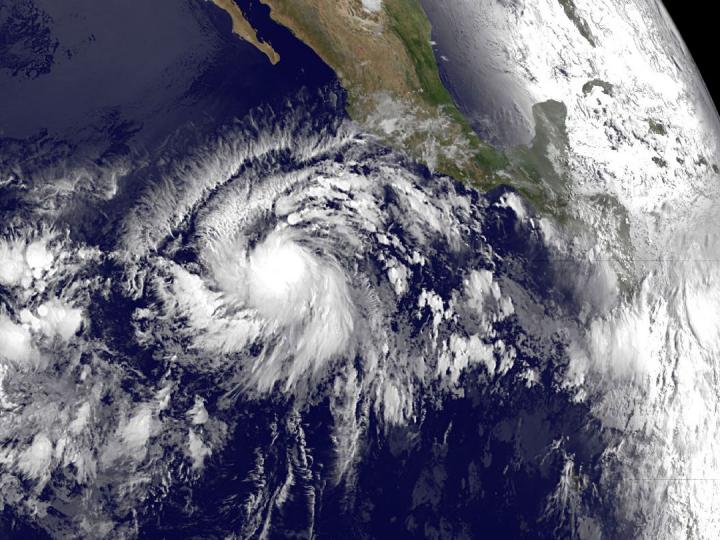First Eastern Pacific tropical depression runs ahead of dawn

NOAA's GOES-West satellite captured an infrared image of the developing depression on May 28 at 1200 UTC (8 a.m. EDT). The GOES image showed a circular center with bands of thunderstorms spiraling into the center from the northwest and southeast. Credits: NASA/NOAA GOES Project
An image of the storm taken from NOAA's GOES-West satellite shows the depression in infrared light as it was born in the early morning hours before sunrise.
To the east of the depression, the GOES image shows the sunlight of dawn reaching Mexico's Yucatan Peninsula.
At 0900 UTC (5 a.m. EDT) the center of Tropical Depression One-E was located near latitude 11.0 North, longitude 110.4 West, ABOUT 685 miles (1,105 km) southwest of Manzanillo Mexico.
The depression is moving toward the west-northwest near 15 mph (24 km/h), but a decrease in forward speed is expected to begin later today.
Maximum sustained winds were near 35 mph (55 km/h) with higher gusts and it is expected to become a tropical storm later today, May 28 and could become a hurricane by late Friday.
The estimated minimum central pressure is 1005 millibars (29.68 inches).
NOAA's GOES-West satellite captured an infrared image of the developing depression on May 28 at 1200 UTC (8 a.m. EDT). The GOES image showed a circular center with bands of thunderstorms spiraling into the center from the northwest and southeast.
The National Hurricane Center (NHC) forecast said that the depression should turn toward the northwest by tonight and the north-northwest by Friday night remaining over open ocean.
Media Contact
All latest news from the category: Earth Sciences
Earth Sciences (also referred to as Geosciences), which deals with basic issues surrounding our planet, plays a vital role in the area of energy and raw materials supply.
Earth Sciences comprises subjects such as geology, geography, geological informatics, paleontology, mineralogy, petrography, crystallography, geophysics, geodesy, glaciology, cartography, photogrammetry, meteorology and seismology, early-warning systems, earthquake research and polar research.
Newest articles

Pinpointing hydrogen isotopes in titanium hydride nanofilms
Although it is the smallest and lightest atom, hydrogen can have a big impact by infiltrating other materials and affecting their properties, such as superconductivity and metal-insulator-transitions. Now, researchers from…

A new way of entangling light and sound
For a wide variety of emerging quantum technologies, such as secure quantum communications and quantum computing, quantum entanglement is a prerequisite. Scientists at the Max-Planck-Institute for the Science of Light…

Telescope for NASA’s Roman Mission complete, delivered to Goddard
NASA’s Nancy Grace Roman Space Telescope is one giant step closer to unlocking the mysteries of the universe. The mission has now received its final major delivery: the Optical Telescope…



